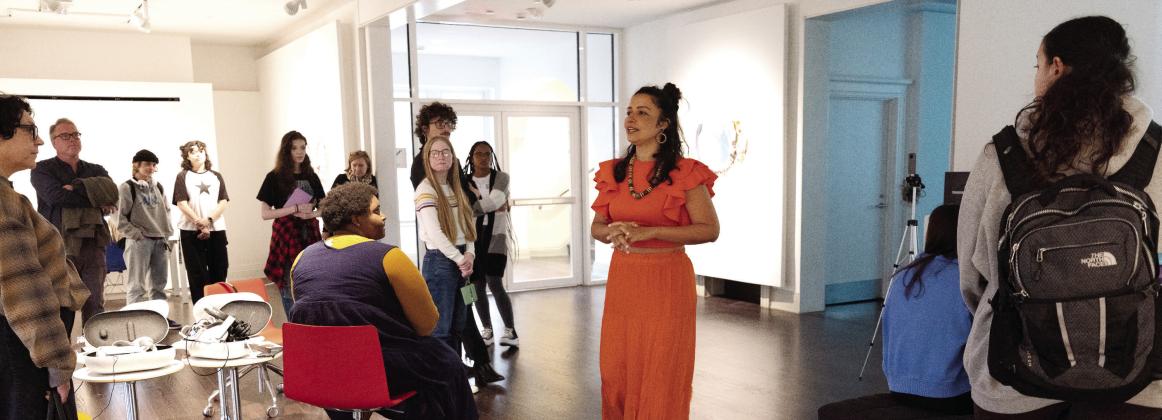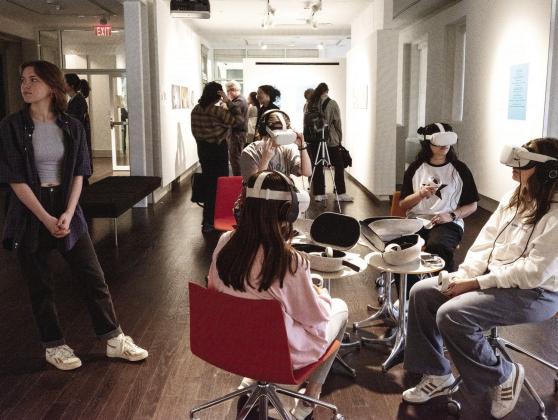Georgia College & State University (GCSU) recently exhibited an awarded and international exhibition called the Transeuntis Mundi Derive 01.
As part of the Visiting Artist program at GCSU, Brazilian artist Cândida Borges was in residency for a week, working with students and installing her work in the Leland Gallery.
The exhibition ran from Feb 24 through March 14, on an invitation from the Chair of the Department of Art's Visiting Artists and Scholars Program Dr. Ruben Yepes, and gallery curator Megan Mcnaught.
The project
The Transeuntis Mundi Project proposed to capture the sound and visual memory of peoples, cultural expressions, and places to artistically tell the story of the millennial passersby who have been crossing the world.
Borges is the musician and transmedia artist who created this work as her Ph.D. thesis in the United Kingdom, in co-authorship with Colombian artist Dr. Gabriel Mario Vélez. Both are artists and scholars who perform and exhibit around the world. They define themselves as nomadic artists.
The exhibition has visited 12 countries and over 20 events so far and has received five important award nominations. Among these prestigious awards was the Lumen Prize, the most important British award for art and technology. This work was also recognized as the top thesis on Art, Science, and Technology of 2022, according to MIT publications.
Derive 01 was the art and technology exhibition of this project presented in the Leland gallery at GCSU, which portrayed the diversity of four countries from four continents and generated a poetical/ documental archive of human cultural heritage.
The expression Transeuntis Mundi comes from Latin, the lingua franca of the expansion of Western Culture. It personifies the human being who has been taking the adventure to discover and explore the world.
Leland Gallery
The Transeuntis Mundi Project was the first art and technology exhibited at the Leland Gallery, which received works on virtual reality, augmented reality, projections, photography, video art, electroacoustic music, and poetry.
The opening night showcased a performance by Borges.
“Cândida opened a whole new world of art for me, and I loved engaging in the art gallery. Her art portrayed many different cultural places and told the story of them at each one just by looking and hearing how it is in that specific place on Earth,” said Molly Dwyer, a GCSU student. “My experience was so helpful and refreshing. I have a whole new outlook on the world from Cândida Borges by looking at the stories and memories at different places around the world.”
Beyond opening night, GCSU students had the opportunity to work with the artist last February, across multiple disciplines. Impressions of the students from the Contemporary Art Seminar, led by Yepes, were positive.
“When I first went into the gallery, I did not realize that the pictures on the walls had more to them than just to admire. I have never really seen anything like that before, especially in a gallery,” said Sarah Sims, a GCSU student. “One of my favorite parts of the exhibition was that the audience was able to participate and get involved. It was very impressive and inspiring to me to try new things when it comes to art. I am very happy we were able to admire her work and hear all about it.”
Dwyer described how innovative the exhibition was and how important it was to form a new generation of artists.
“On my phone, the artwork was coming to life. Being able to experience this was very cool and I feel that it gave me such a new and interesting perspective,” she said. “Another thing that I experienced in the gallery was looking at Candida’s artwork through virtual reality.
" I got to feel what it was like to be in the picture. I traveled all around the world by sitting in a seat. Being able to look around and hear what it was like to be at a certain place in the world was fascinating. Going to this gallery was very eye-opening for me. I got a whole new perspective on art, and what art can be.”
To learn more about the project or see its future destinations visit transeuntismundi.com or search social media. The 2024 season will tour all over Brazil.
“It is extremely important to exhibit in big museums and at universities. This project has a very important interest in working with and forming new artists,” said Borges. “As professors, we feel very happy to share our experience in educational environments.”


